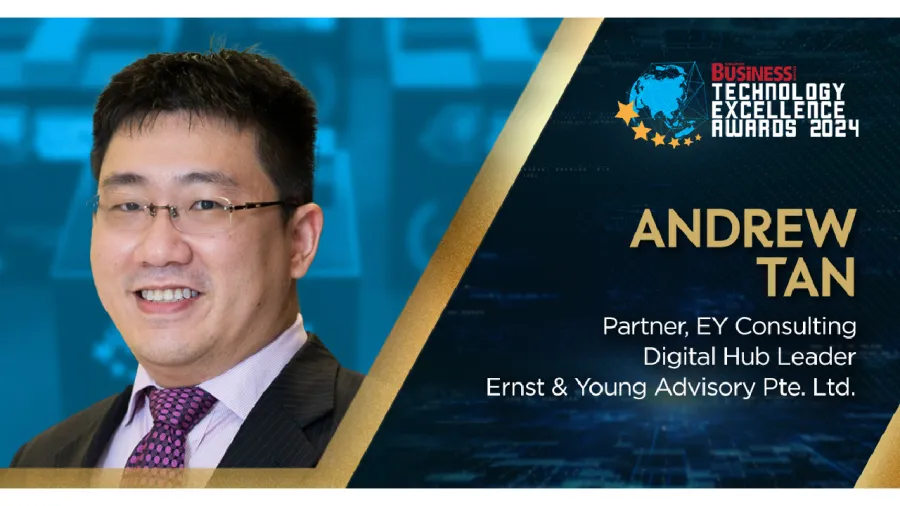
EY’s Andrew Tan offers perspectives on customer empathy-focused technology transformation
Unravel Andrew Tan's insights, offering a compelling glimpse into the future of technology and business.
Businesses today continue to grapple with the imperative to transform and innovate. As the digital realm becomes an integral facet of modern commerce, the complexities of technology transformation take centre stage.
Andrew Tan, a Partner in Consulting at Ernst & Young Advisory Pte. Ltd. Tan is not just an expert in this field but a fervent advocate for digital service delivery grounded in customer empathy and behavior-driven solutions. Tan has honed his expertise in steering digital and emerging technology innovation engagements across Southeast Asia. With a Bachelor's degree in Information Technology (Software Engineering) from Queensland University of Technology, Australia, he brings a wealth of experience to the table.
In this exclusive interview, we delve into Tan's perspectives on technology transformation. His insights unveil an understanding of the delicate balance between innovation and practicality in diverse business sectors. He also shares his experiences in leveraging design thinking and user experience to enhance customer adoption and service quality, offering tangible examples of success. Additionally, we explore his strategic approach to staying ahead of emerging technologies and ensuring sustainable, long-term solutions for clients.
You emphasise the importance of customer empathy in digital service delivery. Can you share a specific example where leveraging design thinking and user experience significantly enhanced customer adoption and service quality in technology transformation?
Good design thinking affects both the online and offline experiences of a customer.
By outlining the customer’s purchase journey and intervening at moments that matter, we can be surgical about designing tactics to increase conversion rates. For example, if the customer has delved into several sports car models, viewed articles around engine power and spent hours comparing the different models online, we can hypothesise that this potential buyer is in a state of confusion over the kind of sports car and may need a physical touchpoint to assuage his or her concerns. The organisation, in this case, a car dealer, could then intervene by sending the buyer a VIP invitation for a test drive.
Upon completion of the test drive, the potential buyer may still be in a state of procrastination and weighing various options. The car dealer can then push out articles or nuggets of information as a reminder of how the car remains the best choice and entice purchase with a further 5% discount.
Empathising with a customer’s physiological state of mind in the purchase journey can significantly enhance adoption and service quality.
Given your entrepreneurial and pragmatic approach, how do you balance the need for innovation with the practical considerations of implementing technology transformation initiatives in diverse business sectors?
Innovate or be left behind. In today’s competitive landscape, innovation is a pillar of growth for many organisations. It’s not always about creating the latest hype but also solving real problems, both new and old, with relevant solutions.
One way that organisations can balance innovation with practical considerations is by utilising the Gartner Hype Cycle. This methodology provides actionable insights into the technology lifecycle, from initial development to commercial adoptability. Organisations can then determine the best entry point for technology transformation (or adoption) by taking into consideration their risk appetite, investment readiness, as well as expected return on investment (ROI), be it immediate operational cost savings, greater process efficiency, product and service line improvement for their existing customer base, or market share expansion. In essence, organisations need to be clear on their objectives and timeframe, and the trickiest would be to put a dollar value on intangibles.
In the rapidly evolving tech landscape, how can companies stay ahead of emerging technologies, and what strategies do you employ to ensure that your clients' solutions are not only innovative but also sustainable in the long term?
Companies can stay ahead of emerging technologies in four ways: by investing in learning and development; supporting employees to allocate time to upskill and stay informed of industry trends through thought leadership events and conferences; fostering a culture of innovation; building strategic partnerships and leveraging partner networks and ecosystems; and being in tune with customer sentiments to enable confident decision-making.
The pace of change has accelerated, such that organisations can be disrupted at any time. Like how the pandemic has forced organisations to make behavioural and structural changes overnight. At EY, we focus on helping organisations reframe their thinking when it comes to business sustainability and growth. For example, with EY wavespace, our clients have the space and freedom to reimagine what is possible (or even impossible) and access our global network and develop strategy roadmaps. By bringing business, design and technology together, organisations can accelerate transformation, drive innovation and create measurable outcomes.
Considering your role as a partner at EY and your commitment to building a better working world through digital innovation, how do you see the role of emerging technologies, such as AI and blockchain, shaping the future of business processes and industry landscapes?
Our role as consultants is to understand and identify suitable use cases and apply them efficiently. Emerging technologies like artificial intelligence (AI), machine learning (ML), and remote work and collaboration tools have a wide scope of potential applications and a strong impact on how we conduct business in the near future. Already, we are seeing AI applications around automation of manual and repetitive tasks, predictive maintenance, productivity assistance and development of new products and services.
Being a strong advocate for robust digital service delivery, what, in your view, are the key challenges organisations face when it comes to effectively implementing and sustaining digital transformation initiatives?
Digital transformation needs buy-in from the leadership and management team. This ensures alignment and commitment across the organisation. At EY, we have done numerous digital transformation service alignment exercises for the organisation’s management to create a clear digital agenda, vision, and roadmap. This will then guide leadership on resource and budget allocation.
Most organisation-level changes require mindset shifts and can lead to employee resistance. Organisations need to identify change champions. Our research shows that digital transformation efforts are known to have a greater success rate with humans at the centre of the journey. Employee engagement is important as it allows them to actively participate in the digital transformation decision-making process and provide valuable on-ground inputs. This fosters ownership and commitment. Beyond that, there is also the need to plan for digital skillset upskilling and reskilling to prepare for plausible job re-designs.
As a judge at the SBR Technology Excellence Awards, what makes a submission stand out in terms of successful technology adoption and impact on business outcomes? What criteria do you consider when assessing the excellence of technology projects?
A successful technology transformation is a combination of four elements: the adoption rate and positive impact on the percentage of the population they service; the innovativeness of the transformation when it comes to leveraging emerging technologies or creating a new approach or methodology; the commercial potential of the solution; and the scalability and sustainability of the transformation.
In addition, I also add a view on the impact of environmental, social and governance (ESG) factors, and with it, responsible and sustainable business practices.



![SBR 5 Lorem Ipsum News 2 [8 May]](https://cmg-qa.s3.ap-southeast-1.amazonaws.com/s3fs-public/styles/exclusive_featured_article/public/2025-05/a_hand_pointing_to_a_futuristic_technology_5b87c9d0e3_3.png.webp?itok=M3Hf-9XR)
![SBR 4 Lorem Ipsum [8 May Top Stories]](https://cmg-qa.s3.ap-southeast-1.amazonaws.com/s3fs-public/styles/exclusive_featured_article/public/2025-05/a_hand_pointing_to_a_futuristic_technology_5b87c9d0e3_2.png.webp?itok=2m5Wl0MX)


![Exclusive three SBR 12 Lorem Ipsum [8 May]](https://cmg-qa.s3.ap-southeast-1.amazonaws.com/s3fs-public/styles/exclusive_featured_article/public/2025-05/a_hand_pointing_to_a_futuristic_technology_5b87c9d0e3_11.png.webp?itok=8kn_UIfA)
![SBR 3 Lorem Ipsum [ Exclusive 2]](https://cmg-qa.s3.ap-southeast-1.amazonaws.com/s3fs-public/styles/exclusive_featured_article/public/2025-05/a_hand_pointing_to_a_futuristic_technology_5b87c9d0e3_1.png.webp?itok=YCyjLegJ)
![SBR 2 Lorem Ipsum [8 May]](https://cmg-qa.s3.ap-southeast-1.amazonaws.com/s3fs-public/styles/exclusive_featured_article/public/2025-05/a_hand_pointing_to_a_futuristic_technology_5b87c9d0e3_0.png.webp?itok=_cKD-29o)

![Video [Event News]](https://cmg-qa.s3.ap-southeast-1.amazonaws.com/s3fs-public/styles/event_news_featured_article/public/2025-05/screenshot-2025-05-08-at-4.58.53-pm_0.png.webp?itok=Kud35sMs)
![Event News SBR 9 Lorem Ipsum [8 may]](https://cmg-qa.s3.ap-southeast-1.amazonaws.com/s3fs-public/styles/event_news_thumbnail/public/2025-05/a_hand_pointing_to_a_futuristic_technology_5b87c9d0e3_8.png.webp?itok=DTh_dbYp)
![Event News SBR 9 Lorem Ipsum [8 May]](https://cmg-qa.s3.ap-southeast-1.amazonaws.com/s3fs-public/styles/event_news_thumbnail/public/2025-05/a_hand_pointing_to_a_futuristic_technology_5b87c9d0e3_7.png.webp?itok=vzDAzb6V)
![Event News SBR 8 Lorem Ipsum [8 May]](https://cmg-qa.s3.ap-southeast-1.amazonaws.com/s3fs-public/styles/event_news_thumbnail/public/2025-05/a_hand_pointing_to_a_futuristic_technology_5b87c9d0e3_6.png.webp?itok=jvHFc4P6)
![Video [Event News]](https://cmg-qa.s3.ap-southeast-1.amazonaws.com/s3fs-public/styles/video_thumbnail/public/2025-05/screenshot-2025-05-08-at-4.58.53-pm_0.png.webp?itok=yZnI0YBb)
![Video 1 SBR [8 May]](https://cmg-qa.s3.ap-southeast-1.amazonaws.com/s3fs-public/styles/video_thumbnail/public/2025-05/screenshot-2025-05-08-at-4.58.53-pm.png.webp?itok=9AAeRz_k)

 Advertise
Advertise

